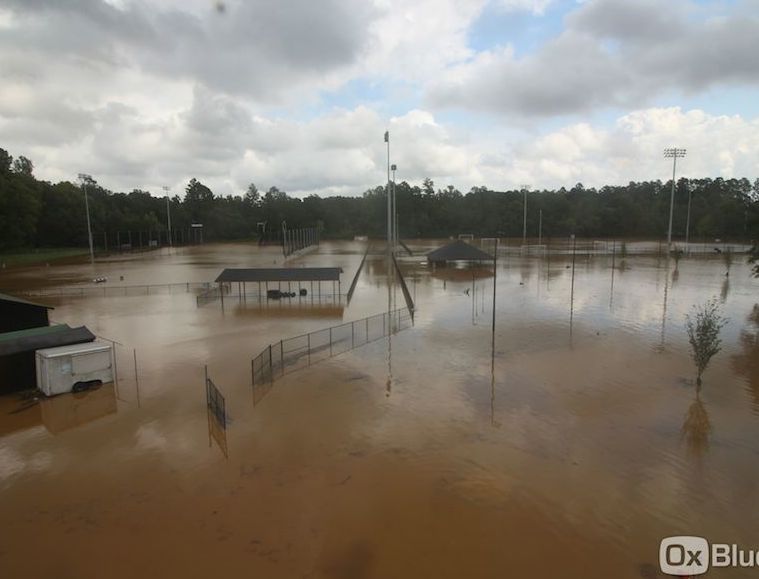This article was sent to SportsTurf by USGreentech, a subsidiary of STMA member The Motz Group, which has been building athletic fields for 40 years.
In the fall of 2017, the University of North Carolina at Chapel Hill built two synthetic turf fields at the Finley Athletic Complex. With the understanding that the fields were located within Chapel Creek’s floodplain, the athletic design firm hired by the school, FitFields, chose Envirofill infill, along with a Brock International pad and FieldTurf hybrid dual fiber with thatch for additional infill stabilization.
One year later, that system design was put to the test when last September Hurricane Florence hit the Carolinas and dropped more than 37 inches of rain to become the wettest cyclone ever recorded in the region. More than 3 feet of water covered the practically new fields. The real-life experiences of that extreme flood event and the restoration afterward offer great guidance when considering a synthetic field situated in similar environmental conditions.
Planning for the potential future
Dan Dodd, founder and president of South Carolina-based FitFields, explains the design and decision process that went into UNC’s fields:
“The turf face weight was slightly higher than what we would recommend for traditional systems, but the added fiber weight was an additional factor that helped us develop an overall mitigation plan for a potential flood event. We felt our weighted system did not need a customized header attachment to the composite wood nailer board. A traditional connection was made since we had so much weight per square foot on the field. We felt that the “bubble” effect would have less of a chance occur based on the weighted design.”
Selecting the right infill is one of the most important decisions when planning for a potential flood event. Many infills have a specific gravity less than 1.0, which means they will float. After deciding on the type of infill, the second important decision is ensuring that the amount in the system can overcome the buoyancy of the pad. You want to make sure that the system is negatively buoyant, meaning that the pad stays put and doesn’t even start to float. The buoyancy of the common pads on the market range from 4.5 pounds to more than 7.5 pounds per square foot. For the UNC project, 8 pounds of Envirofill was used. Composed of Texas quartz sand coated in acrylic and permanently infused with Microban antibacterial, Envirofill has a high specific gravity (2.65) that helps it and stay within the synthetic turf. Microban technology that protects the infill against the bacteria, mold and mildew that would be present after the flood recedes.
Dan Dodd continues: “The third issue that was studied in detail, was to ensure that we had an infill system that would not migrate across the field plane while keeping the 0.5% field drainage slope. The field slope was vital for hydraulic performance and we did not want to take the risk with a slow draining, flat field drainage system. Overall, it was critical not to have any infill wash into the adjacent stream corridor.
“We also placed drain basin cleanouts at the high point between both fields as a potential air pressure release. The concept was simple, as the flood waters would recede from the high point between the fields, the contained air pressure in the submerged pipe system would have the ability to vent from the cleanouts at the same rate as the receding flood.”
In October 2012, Hurricane Sandy hit the Eastern seaboard and inundated New York City with several feet of water. Many artificial turf fields in NYC were flooded, including several at Kingsborough Community College in Queens that were installed with Envirofill, a decision that was made because of the fields’ location only 600 feet from the ocean. The infill, turf and pad stayed in place and were back in play shortly after the waters receded. Other fields nearby saw their infill carried away and the pads and turf floated, wrinkled and displaced, rendering them unplayable.
Aftermath of Hurricane Florence
So how did UNC’s fields fare through Hurricane Florence? Just 24 hours after the floodwater receded the lacrosse and soccer teams were back practicing on the fields.
Much credit goes to Casey Carrick, CSFM, Director of Athletic Grounds and Turf Management at UNC, and his team who executed a recovery and restoration plan that should become standard operating procedure for similar situations.
As Casey explained, “Our team got right to work as the nearby natural turf fields had been covered in nearly 8 feet of water and were in rough shape. They would be out of commission for awhile. While we were waiting for the sun to dry out the synthetic surface, we removed all the debris from the field. We then used a drag behind brush to break up the dried silt from the blades. On the next two passes we used a GKB vacuum (STEC Equipment), which pulled silt from the infill up to the surface where it could be removed. We then finished it with a Buffalo blower. The infill stayed in the turf and there was none noticed outside the field. We were very impressed with how well these fields performed and how quickly the team was able to get back onto the fields.”
No two flood events are the same. Some floods can be very fast moving and last for days or weeks scouring the earth in its wake. Some can be slow moving backwater and recede rather quickly leaving behind a lot of silt. And some can be due to tidal surge. Because no two events are exactly the same, its takes a skilled field designer to anticipate the conditions and design the field appropriately to give it the best chance of surviving the flood.


